Explosive Spalling Behavior of Single-Sided Heated Concrete According to Compressive Strength and Heating Rate
Abstract
:1. Introduction
2. Experiment
2.1. Experimental Plan
2.2. Heating Method
2.3. Calculation of Restrained Stress and Z-Axis Stress in Concrete
3. Experimental Results and Discussion
3.1. Spalling Type and Internal Temperature
3.2. Vapor Pressure
3.3. Restrained Stress in Ring-Restrained Concrete
3.4. Spalling Behavior According to Vapor Pressure and Restrained Stress
4. Conclusions
- Because concrete has a low thermal conductivity, an internal temperature difference occurs depending on the heating rate. In particular, the temperature gradient of concrete may increase under a single-sided heating condition. The temperature difference inside concrete affects the formation of vapor pressure and restrained stress, which are important factors that determine the spalling type. The temperature difference inside concrete is large and continuous surface spalling occurs under fast heating, whereas the temperature difference inside concrete is small and explosive spalling occurs under slow heating.
- Under fast heating, the heated surface of concrete is continuously peeled off and small concrete debris is generated in large quantities owing to the surface spalling of concrete. However, under slow heating, explosive spalling of concrete involves an impact and generates a very large concrete fracture. In particular, explosive spalling may cause rapid strength degradation because it may lead to a rapid cross-sectional loss. It was confirmed that the spalling type of concrete has a significant influence on the cross-sectional loss pattern.
- For high-strength concrete with a dense internal structure, moisture migration occurs when the internal temperature increases, and the inward-migrated moisture forms moisture clogging in the supersaturated state. Under fast heating, the temperature difference in concrete between the surface and the inside was large, therefore, repeated surface spalling occurred owing to the moisture clogging formed on the heated surface of the concrete and the rapidly increasing restrained stress. Under slow heating, moisture migration was not active because the temperature was evenly distributed from the surface to the inside of the concrete, but explosive spalling occurred owing to the moisture clogging forming in a deep area of the concrete and the restrained stress slowly increased. The moisture clogging and restrained stress formed by the temperature distribution in high-strength concrete significantly affect the spalling type.
- Concrete exhibited surface or explosive spalling depending on the heating condition and compressive strength. The cross-sectional loss pattern varies depending on the spalling type and can affect the strength degradation of concrete. For surface spalling, the strength of concrete can be conserved if part of the cross-sectional loss is inhibited. However, the occurrence of explosive spalling may cause a rapid strength degradation of concrete. As the strength degradation of concrete affects the structural stability of concrete structures, it is necessary to control concrete spalling considering the heating condition and compressive strength.
Author Contributions
Funding
Institutional Review Board Statement
Informed Consent Statement
Acknowledgments
Conflicts of Interest
References
- Choe, G.C.; Kim, G.Y.; Gucunski, N.; Lee, S.H. Evaluation of the mechanical properties of 200MPa ultra-high-strength concrete at elevated temperatures and residual strength of column. Constr. Build. Mater. 2015, 86, 159–168. [Google Scholar] [CrossRef]
- Kodur, V.K.R. Spalling in high strength concrete exposed to fire-concerns, causes, critical parameters and cures. In Proceedings of the Structures Congress, Advanced Technology in Structural Engineering, Philadelphia, PA, USA, 8–10 May 2000. [Google Scholar]
- Khoury, G.A. Effect of fire on concrete and concrete structures. Prog. Struct. Eng. Mater. 2000, 2, 429–447. [Google Scholar] [CrossRef]
- Rossino, C.; Lo Monte, F.; Cangiano, S.; Felicetti, R.; Gambarova, P.G. HPC subjected to high temperature: A study on intrinsic and mechanical damage. Key Eng. Mater. 2015, 629, 239–244. [Google Scholar] [CrossRef]
- Fu, Y.; Li, L. Study on mechanism of thermal spalling in concrete exposed to elevated temperatures. Mater. Struct. 2011, 44, 361–376. [Google Scholar] [CrossRef]
- Li, L.; Khan, M.; Bai, C.; Shi, K. Uniaxial Tensile Behavior, Flexural Properties, Empirical Calculation and Microstructure of Multi-Scale Fiber Reinforced Cement-Based Material at Elevated Temperature. Materials 2021, 14, 1827. [Google Scholar] [CrossRef]
- Khan, M.; Cao, M.; Chaopeng, X.; Ali, M. Experimental and analytical study of hybrid fiber reinforced concrete prepared with basalt fiber under high temperature. Fire Mater. 2021. [Google Scholar] [CrossRef]
- Farzampour, A. Compressive behavior of concrete under environmental effects. In Compressive Strength of Concrete; IntechOpen: London, UK, 2019. [Google Scholar]
- Kalifa, P.; Menneteau, F.D.; Quenard, D. Spalling and pore pressure in HPC at high temperatures. Cem. Concr. Res. 2000, 30, 1915–1927. [Google Scholar] [CrossRef]
- Mugume, R.B.; Horiguchi, T. Pore pressure development in hybrid fibre-reinforced high strength concrete at elevated temperatures. Cem. Concr. Res. 2011, 41, 1150–1156. [Google Scholar]
- Ozawa, M.; Morimoto, H. Effects of various fibres on high-temperature spalling in high-performance concrete. Constr. Build. Mater. 2014, 71, 83–92. [Google Scholar] [CrossRef]
- Kalifa, P.; Chene, G.; Galle, C. High-temperature behaviour of HPC with polypropylene fibres from spalling to microstructure. Cem. Concr. Res. 2001, 31, 1487–1499. [Google Scholar] [CrossRef]
- Suhaendi, S.L.; Horiguchi, T. Effect of short fibers on residual permeability and mechanical properties of hybrid fibre reinforced high strength concrete after heat exposition. Cem. Concr. Res. 2006, 36, 1672–1678. [Google Scholar] [CrossRef]
- Choe, G.C.; Kim, G.Y.; Kim, H.S.; Hwang, E.C.; Lee, S.K.; Son, M.J.; Nam, J.S. Influence of amorphous metallic fibers on spalling properties of high-strength concrete exposed to high temperature. Constr. Build. Mater. 2020, 263, 120711. [Google Scholar] [CrossRef]
- Lee, G.C.; Han, D.Y.; Han, M.C.; Han, C.G.; Son, H.J. Combining polypropylene and nylon fibers to optimize fiber addition for spalling protection of high-strength concrete. Constr. Build. Mater. 2012, 34, 313–320. [Google Scholar] [CrossRef]
- Hager, I.; Mróz, K. Role of polypropylene fibres in concrete spalling risk mitigation in fire and test methods of fibres effectiveness evaluation. Materials 2019, 12, 3869. [Google Scholar] [CrossRef] [Green Version]
- Lee, T.; Kim, G.; Choe, G.; Hwang, E.; Lee, J.; Ryu, D.; Nam, J. Spalling resistance of fiber-reinforced ultra-high-strength concrete subjected to the ISO-834 standard fire curve: Effects of thermal strain and water vapor pressure. Materials 2020, 13, 3792. [Google Scholar] [CrossRef]
- Zhang, D.; Liu, Y.; Tan, K.H. Spalling resistance and mechanical properties of strain-hardening ultra-high performance concrete at elevated temperature. Constr. Build. Mater. 2021, 266, 120961. [Google Scholar] [CrossRef]
- Kodur, V.K.R.; Phan, L. Critical factors governing the fire performance of high strength concrete systems. Fire Saf. J. 2007, 42, 482–488. [Google Scholar] [CrossRef]
- Li, Y.; Tan, K.H.; Yang, E.H. Synergistic effects of hybrid polypropylene and steel fibers on explosive spalling preven-tion of ultra-high performance concrete at elevated temperature. Cem. Concr. Compos. 2019, 96, 174–181. [Google Scholar] [CrossRef]
- Hertz, K.D. Heat Induced Explosion of Dense Concretes; Report 166, CIB W14/84/33(DK); Institute of Building Design (Now Department of Buildings and Energy), Technical University of Denmark: Lynby, Denmark, 1984; p. 20. [Google Scholar]
- Algourdin, N.; Pliya, P.; Beaucour, A.L.; Simon, A.; Noumowé, A. Influence of polypropylene and steel fibres on thermal spalling and physical-mechanical properties of concrete under different heating rates. Constr. Build. Mater. 2020, 259, 119690. [Google Scholar] [CrossRef]
- Phan, L.T.; Lawson, J.R.; Davis, F.L. Effects of elevated temperature exposure on heating characteristics, spalling, and residual properties of high performance concrete. Mater. Struct. 2001, 34, 83–91. [Google Scholar] [CrossRef]
- Phan, L.T. Pore pressure and explosive spalling in concrete. Mater. Struct. 2008, 41, 1623–1632. [Google Scholar] [CrossRef]
- Choe, G.; Kim, G.Y.; Yoon, M.H.; Hwang, E.C.; Nam, J.S.; Gucunski, N. Effect of moisture migration and water vapor pressure build-up with the heating rate on concrete spalling type. Cem. Concr. Res. 2019, 116, 1–10. [Google Scholar] [CrossRef]
- Ozawa, M.; Tanibe, T.; Kamata, R.; Uchida, Y.; Rokugo, K.; Parajulia, S.S. Behavior of ring-restrained high-performance concrete under extreme heating and development of screening test. Constr. Build. Mater. 2018, 162, 215–228. [Google Scholar] [CrossRef]
- Ozawa, M.; Shaikh, F.U.A. A study on spalling behaviour of geopolymer mortars using ring restraint test. Constr. Build. Mater. 2021, 279, 122494. [Google Scholar] [CrossRef]
- International Standards Organizations. Fire Resistance Tests. Elements of Building Construction; ISO 834; ISO: Geneva, Switzerland, 1980. [Google Scholar]
- Rilem, T.C. Test methods for mechanical properties of concrete at high temperatures: Part 3—Compressive strength for service and accident conditions. Mater. Struct. 1995, 28, 410–414. [Google Scholar]
- Timoshenko, S. Theory of Plates and Shells, 2nd ed.; McGraw-Hill Book Company: New York, NY, USA, 1959. [Google Scholar]
- Ichikawa, Y.; England, G.L. Prediction of moisture migration and pore pressure build-up in concrete at high temperatures. Nucl. Eng. Des. 2004, 228, 245–259. [Google Scholar] [CrossRef] [Green Version]
- Hermathy, T.Z. Effect of moisture on the fire endurance of building materials moisture in relation to fire tests. ASTM Spec. Tech. Publ. 1965, 385, 74–95. [Google Scholar]
- Jansson, R. Fire spalling of concrete—A historical overview. MATEC Web Conf. 2013, 6, 01001. [Google Scholar] [CrossRef] [Green Version]
- CEN. Eurocode 2—Design of Concrete Structure; European Standard EN 1992; European Committee for Standardization: Brussels, Belgium, 2004. [Google Scholar]
- Michikoshi, S.; Kobayashi, Y.; Kuroiwa, S. Strain behaviour of compression concrete at high temperature. AIJ J. 2007, 621, 169–174. (In Japanese) [Google Scholar]
- Li, Y.; Zhang, D. Effect of lateral restraint and inclusion of polypropylene and steel fibers on spalling behavior, pore pressure, and thermal stress in ultra-high-performance concrete (UHPC) at elevated temperature. Constr. Build. Mater. 2021, 271, 121879. [Google Scholar] [CrossRef]
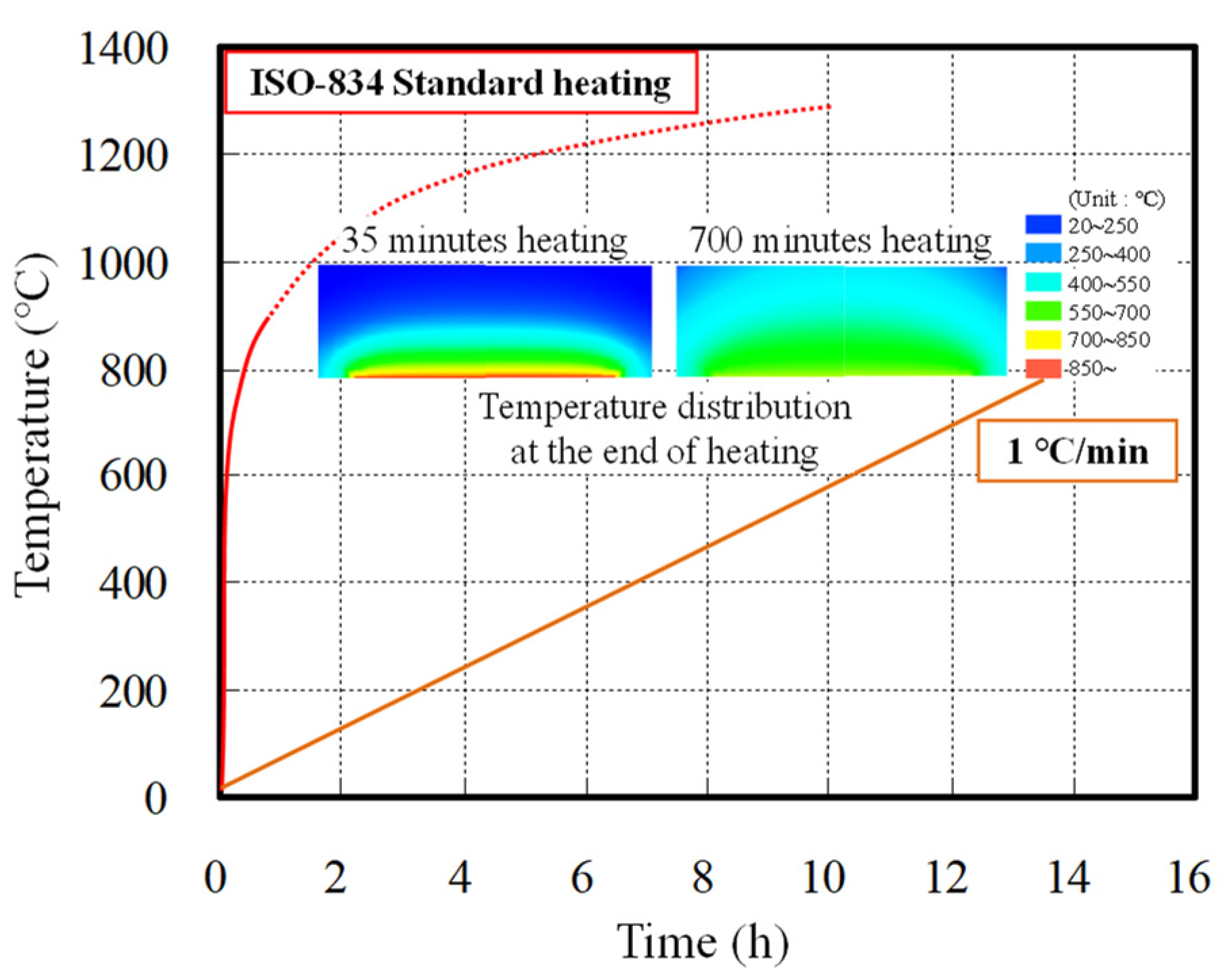
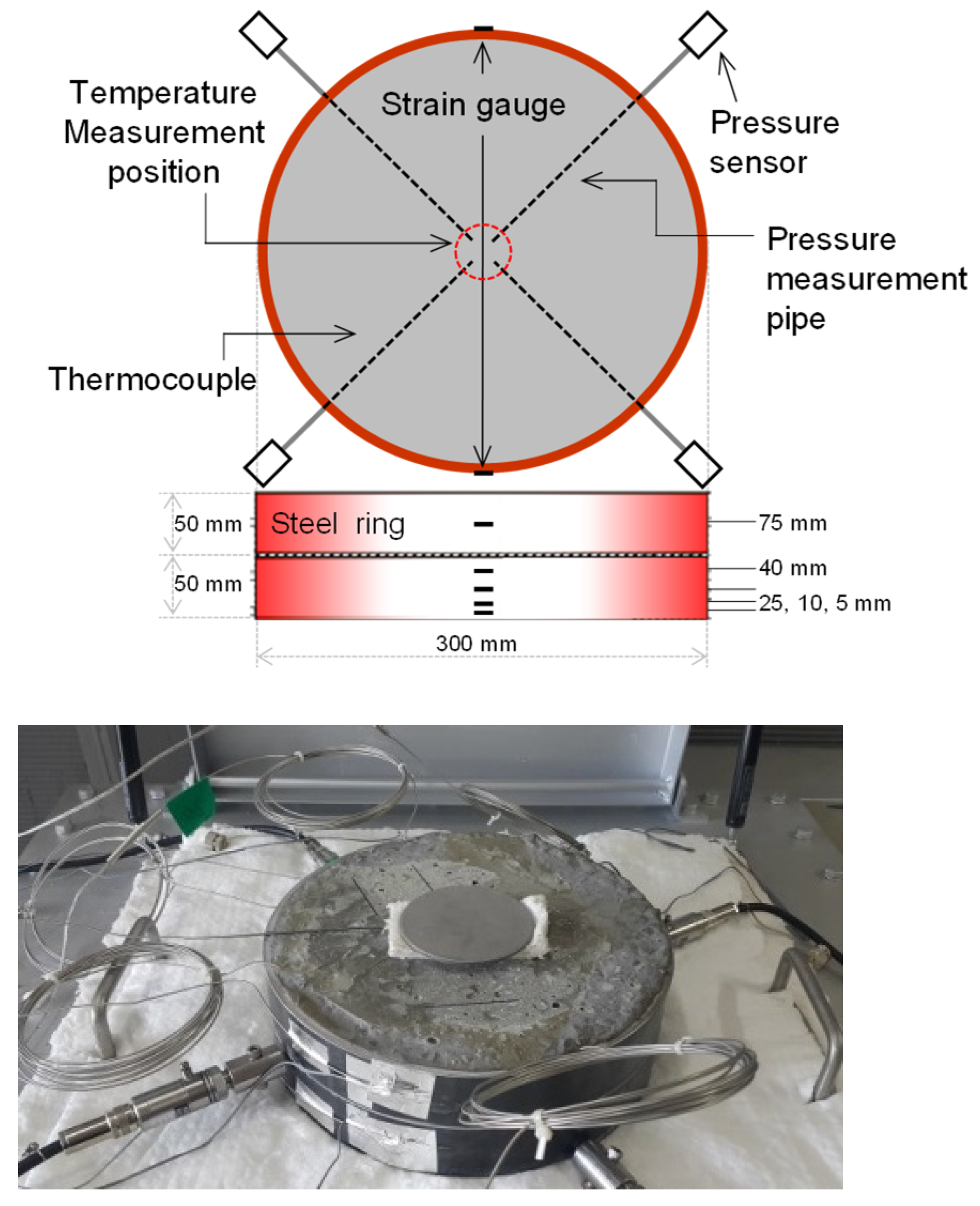
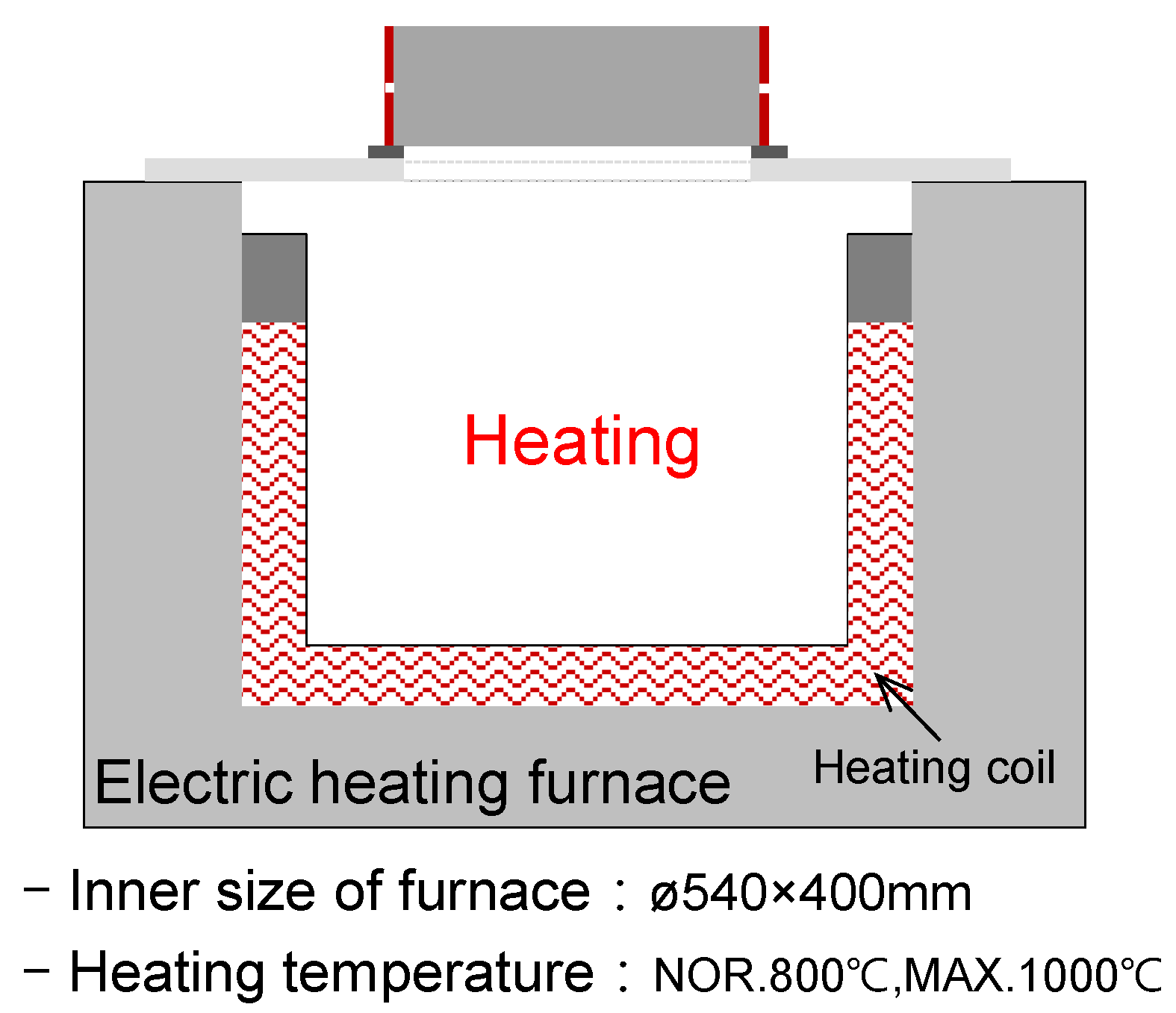
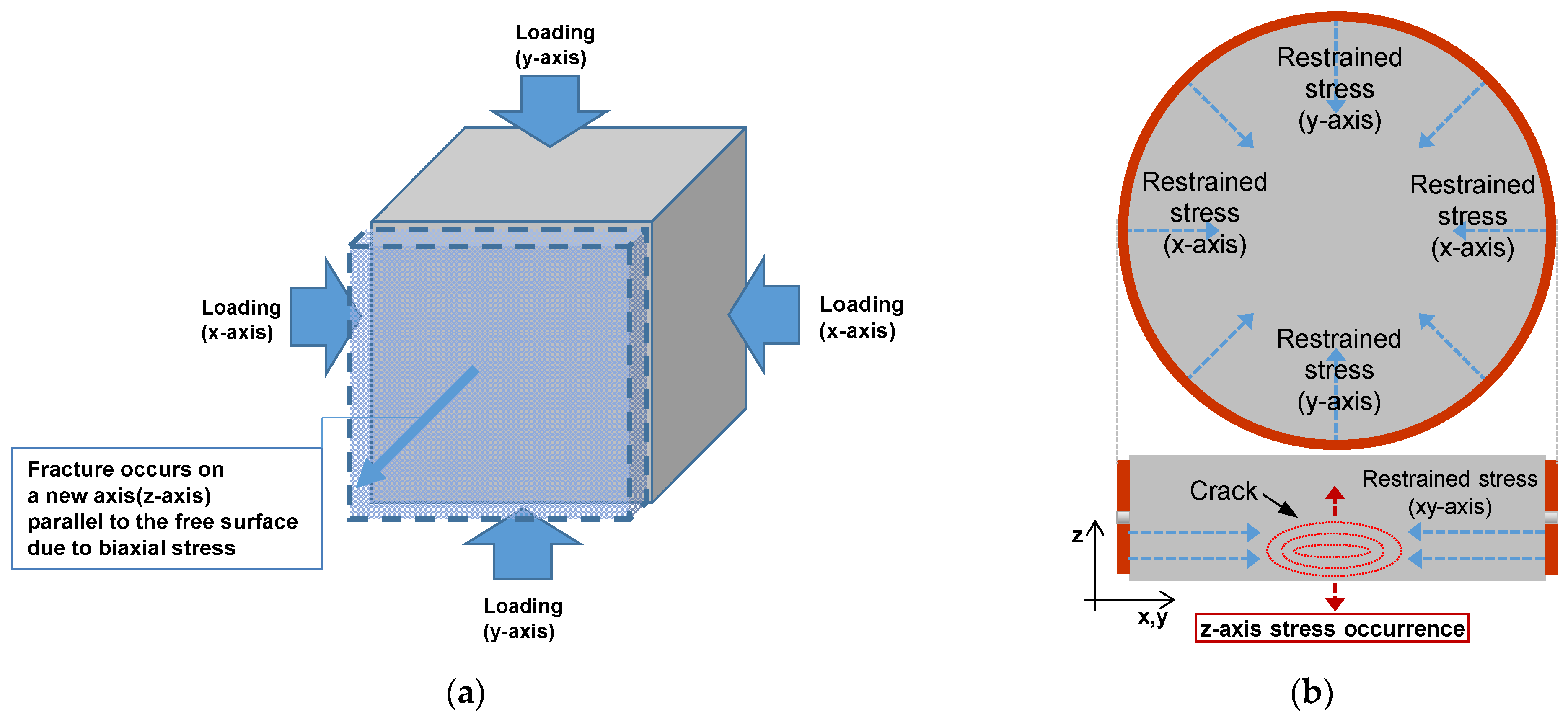
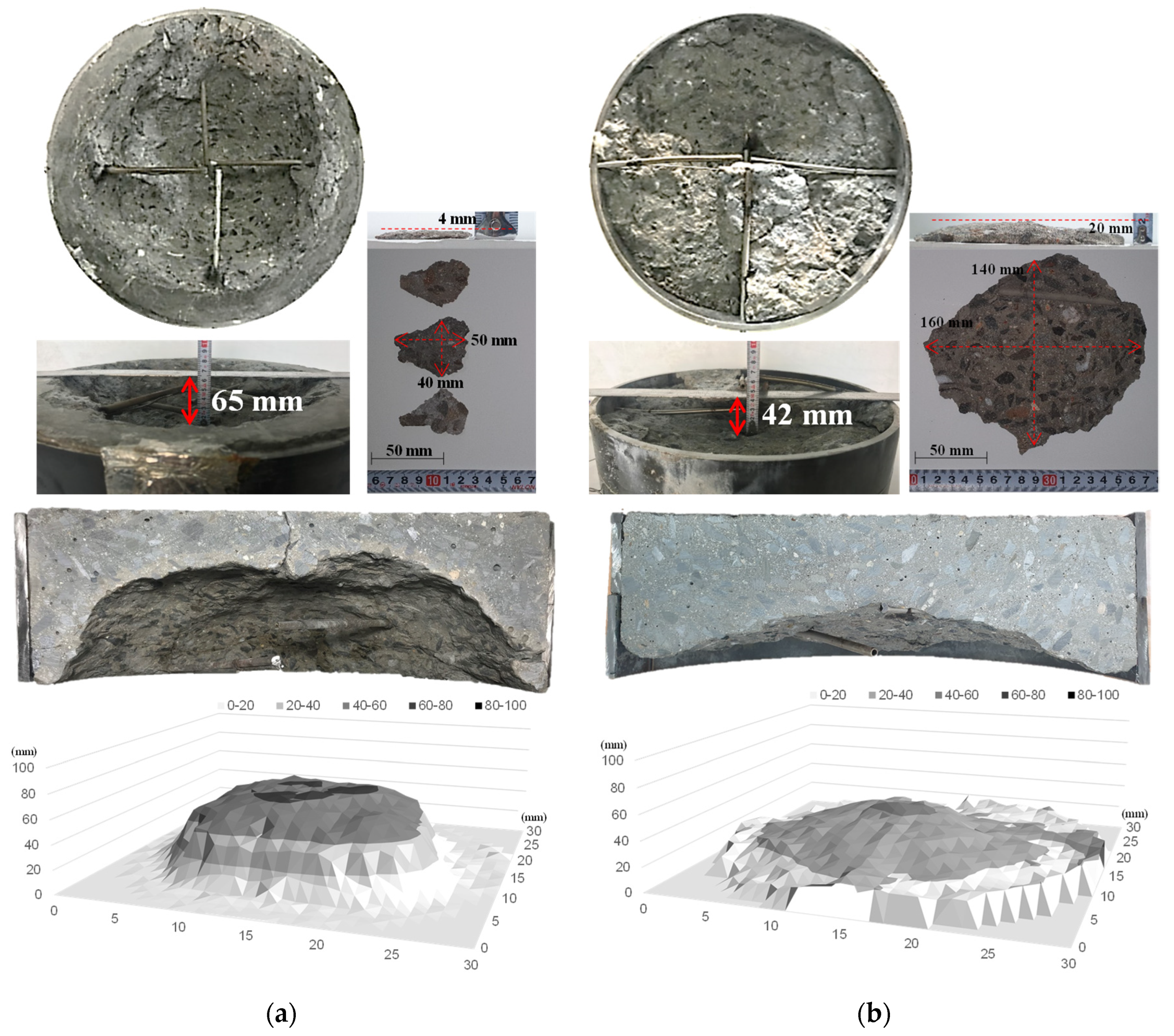
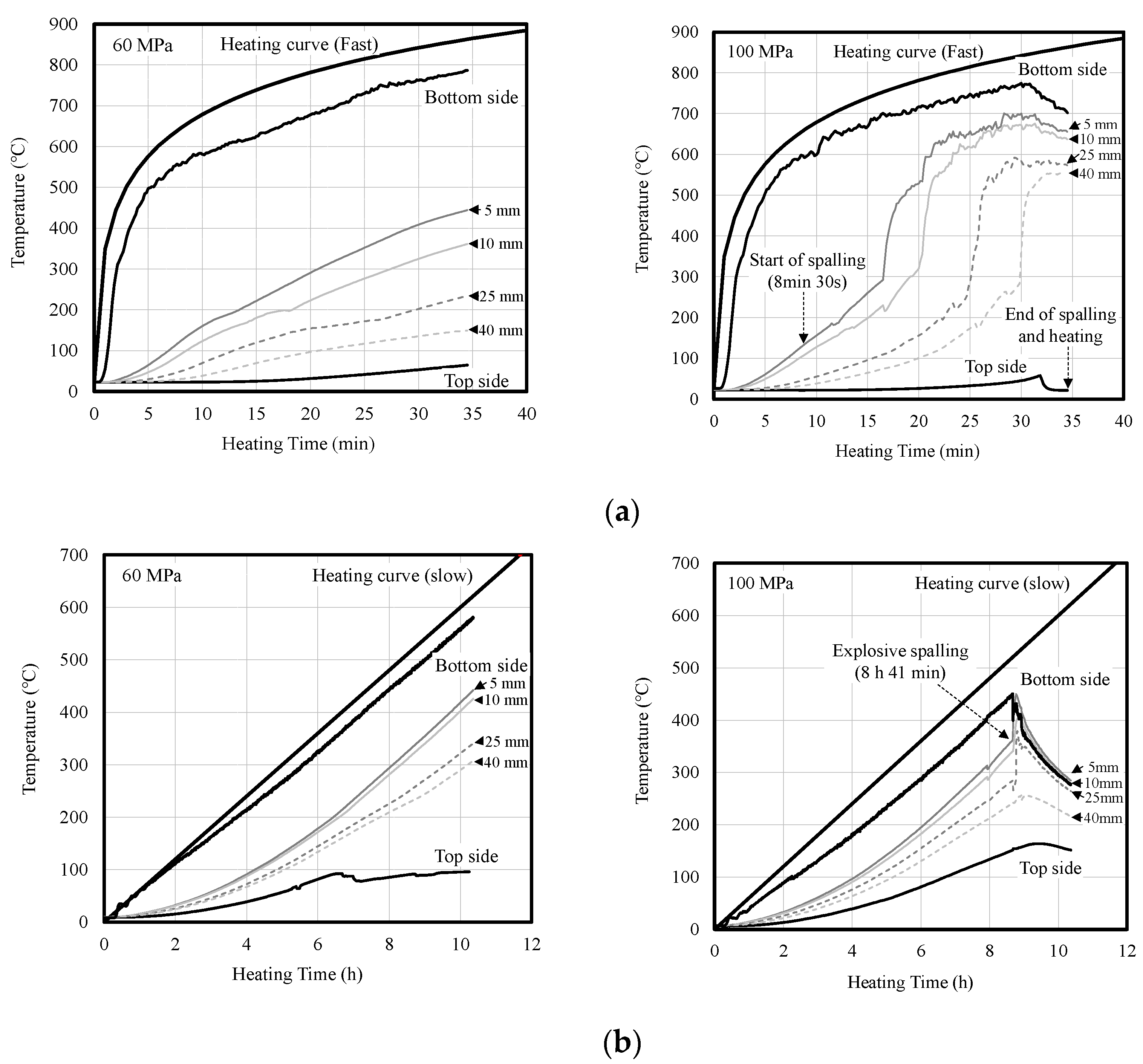
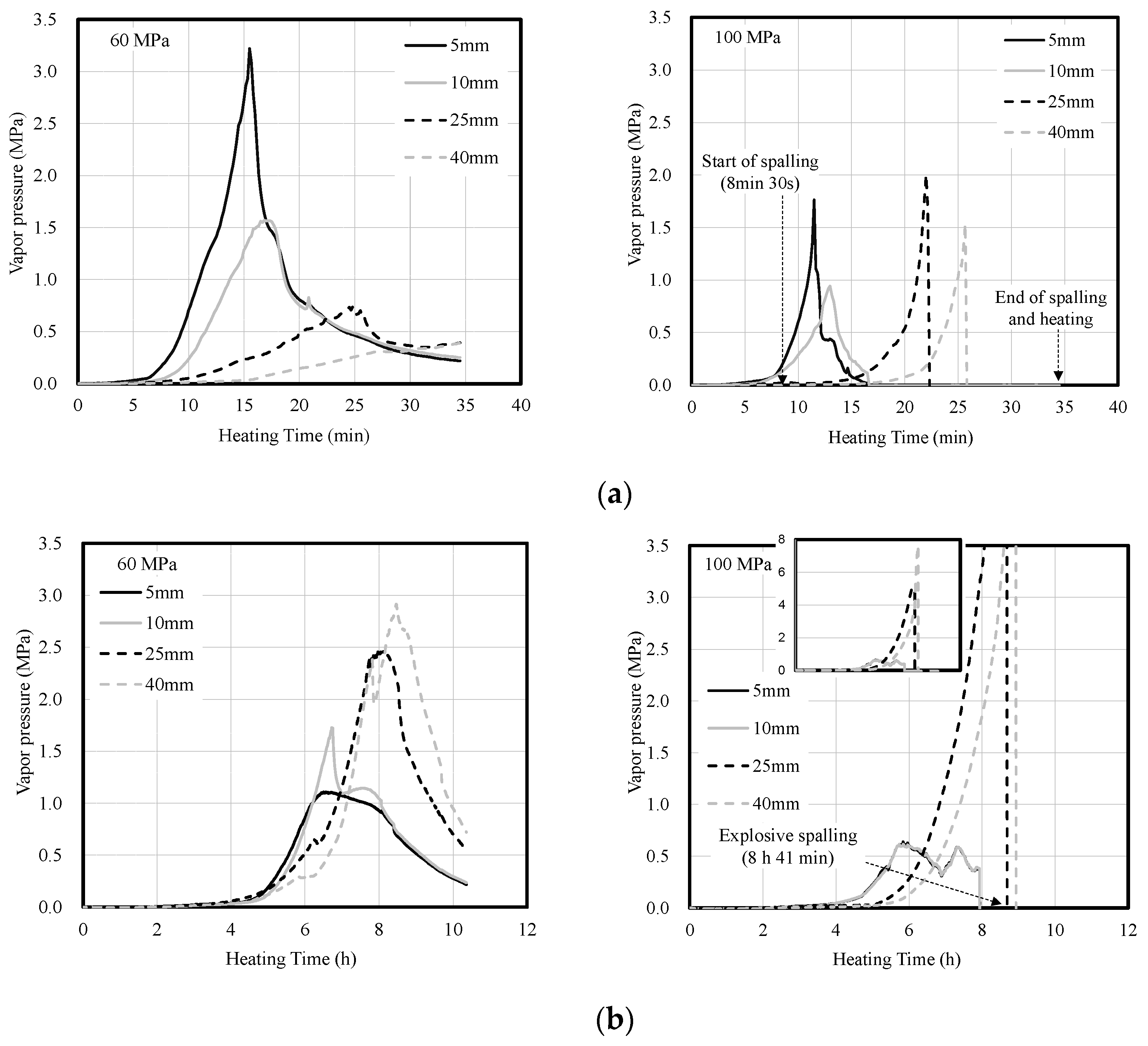
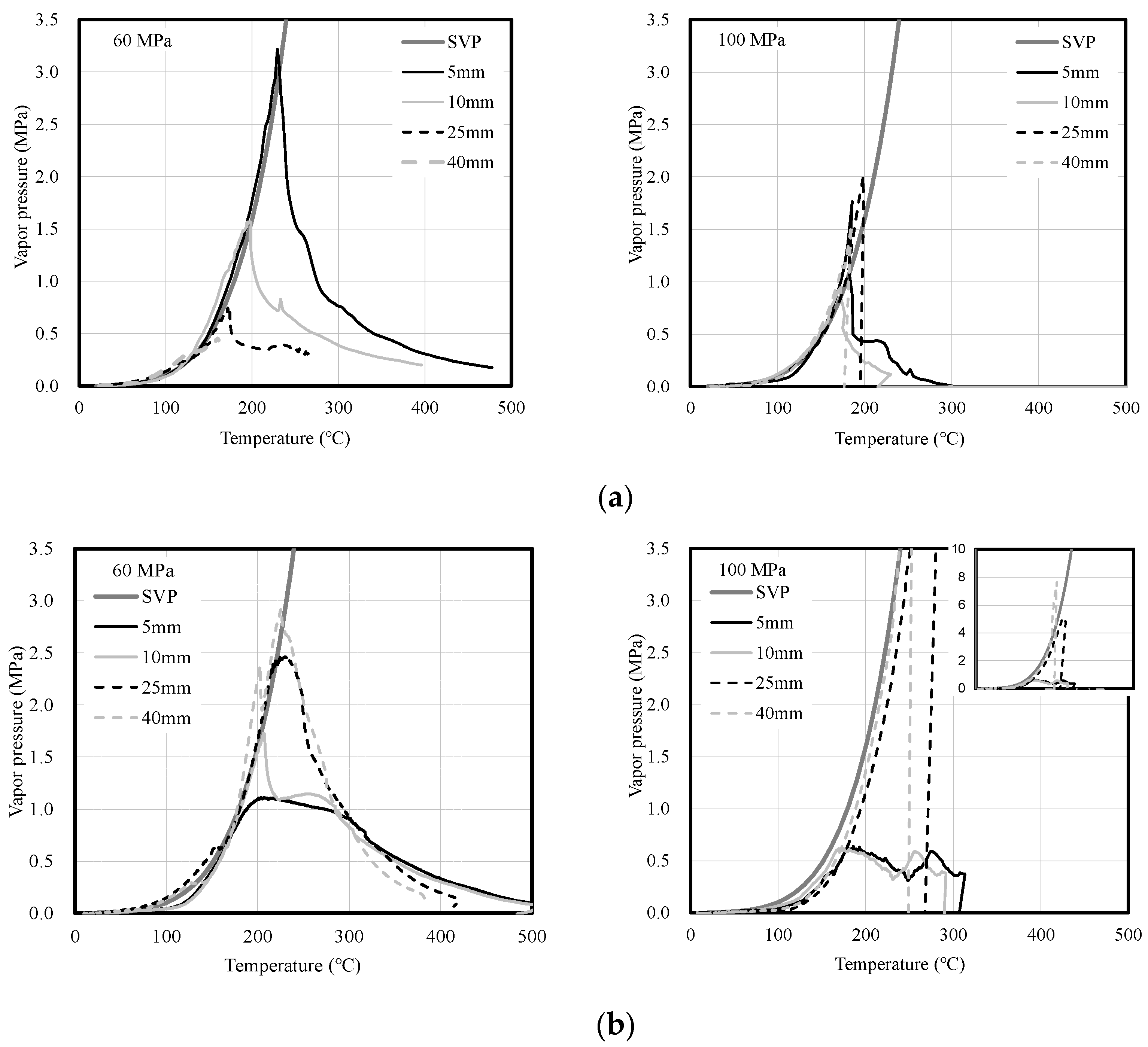
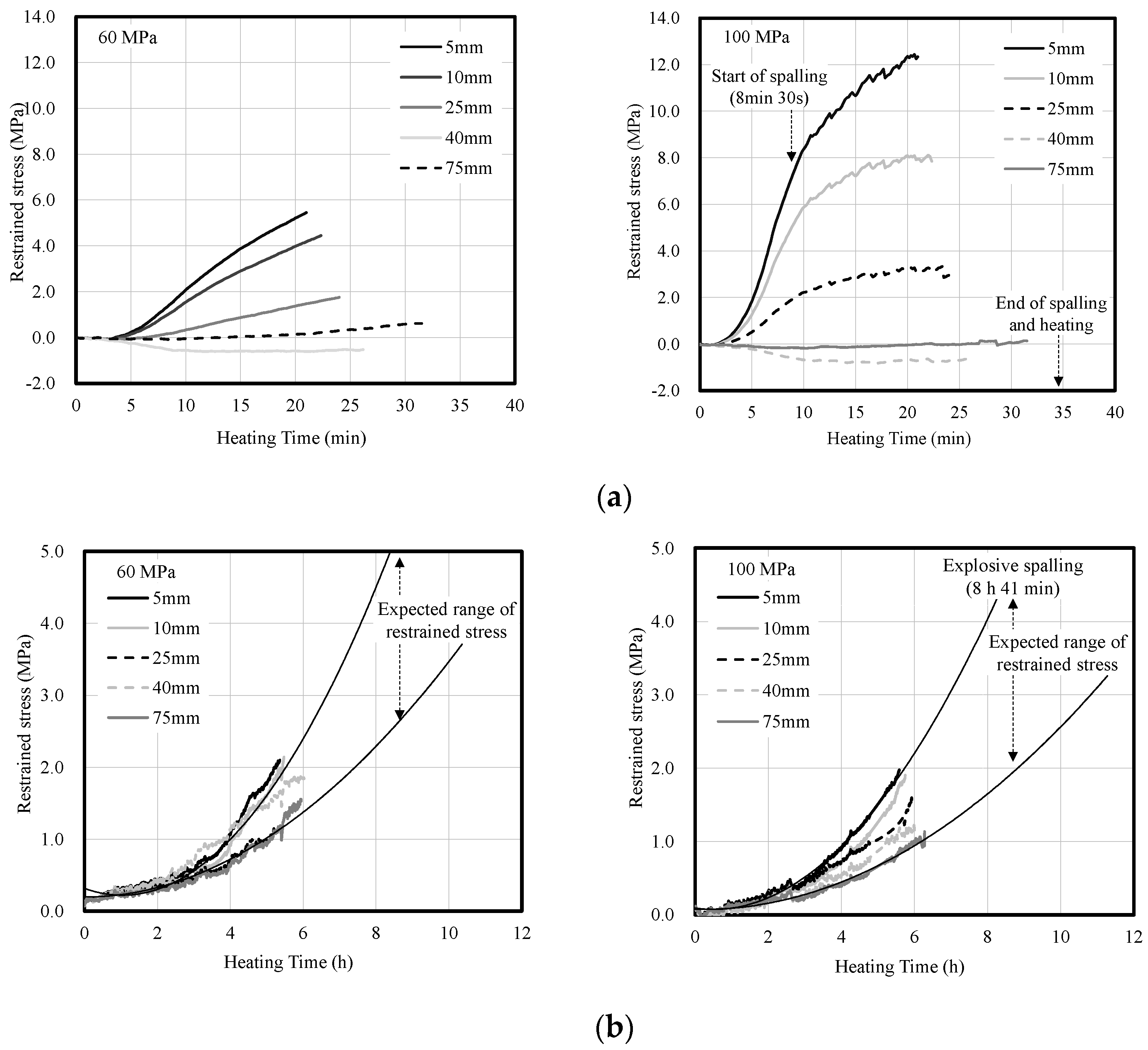
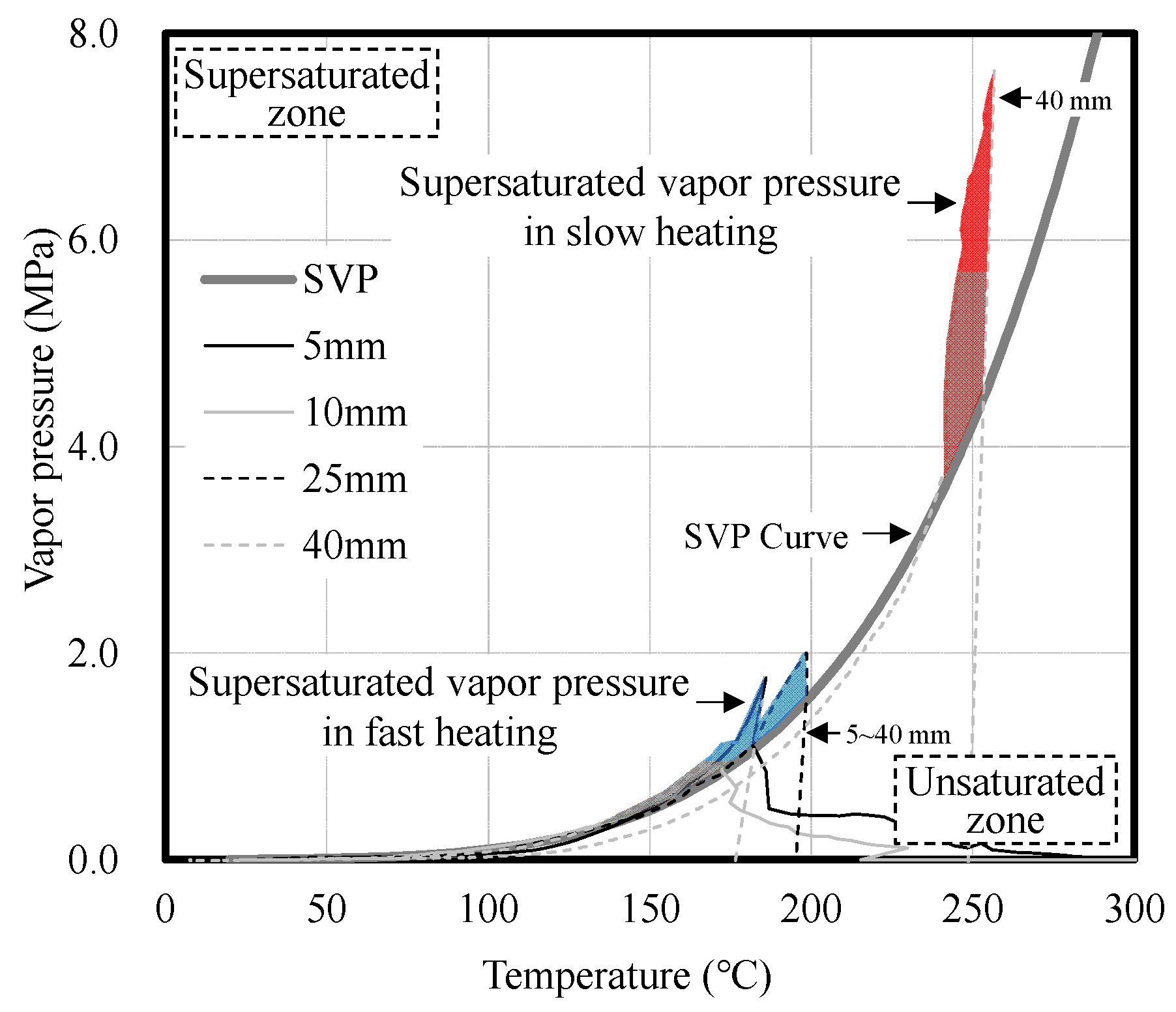
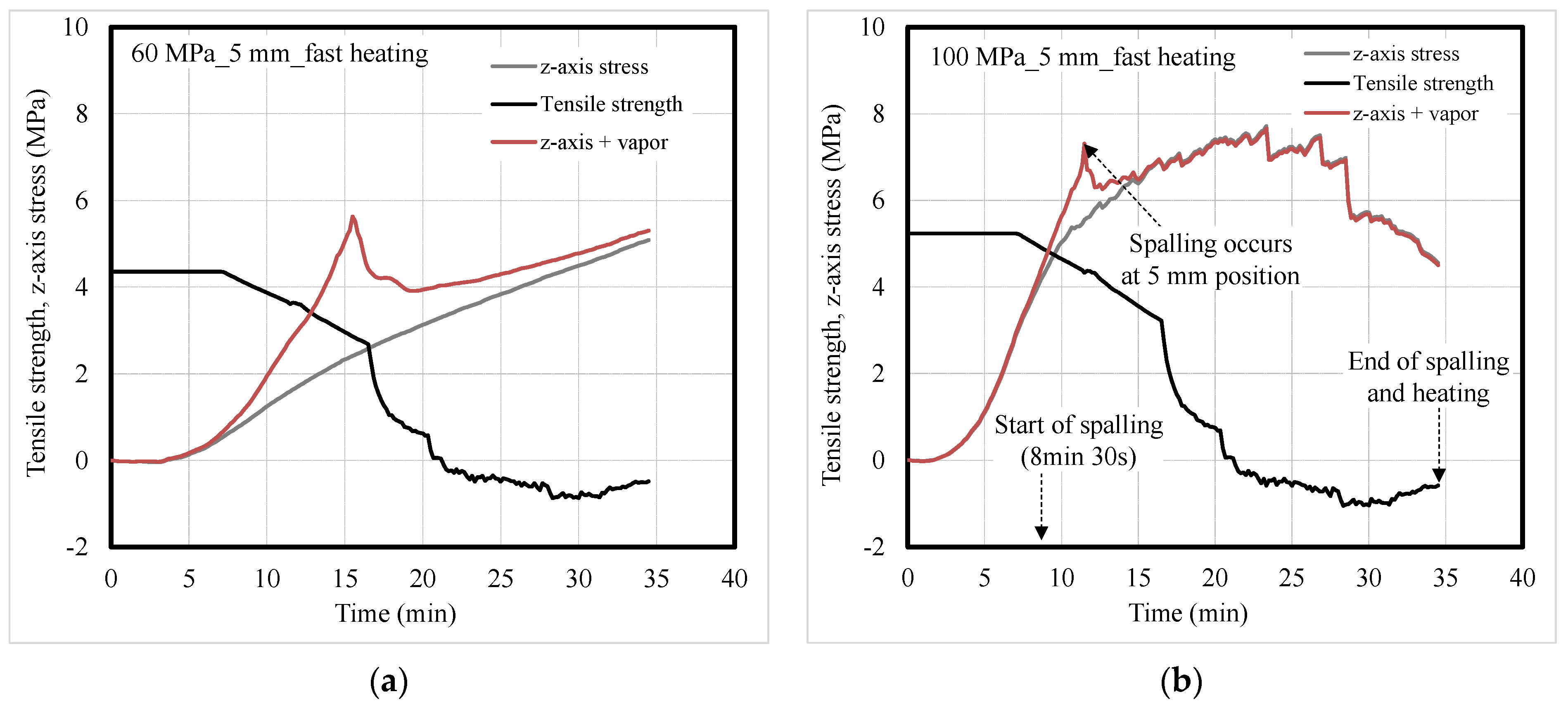
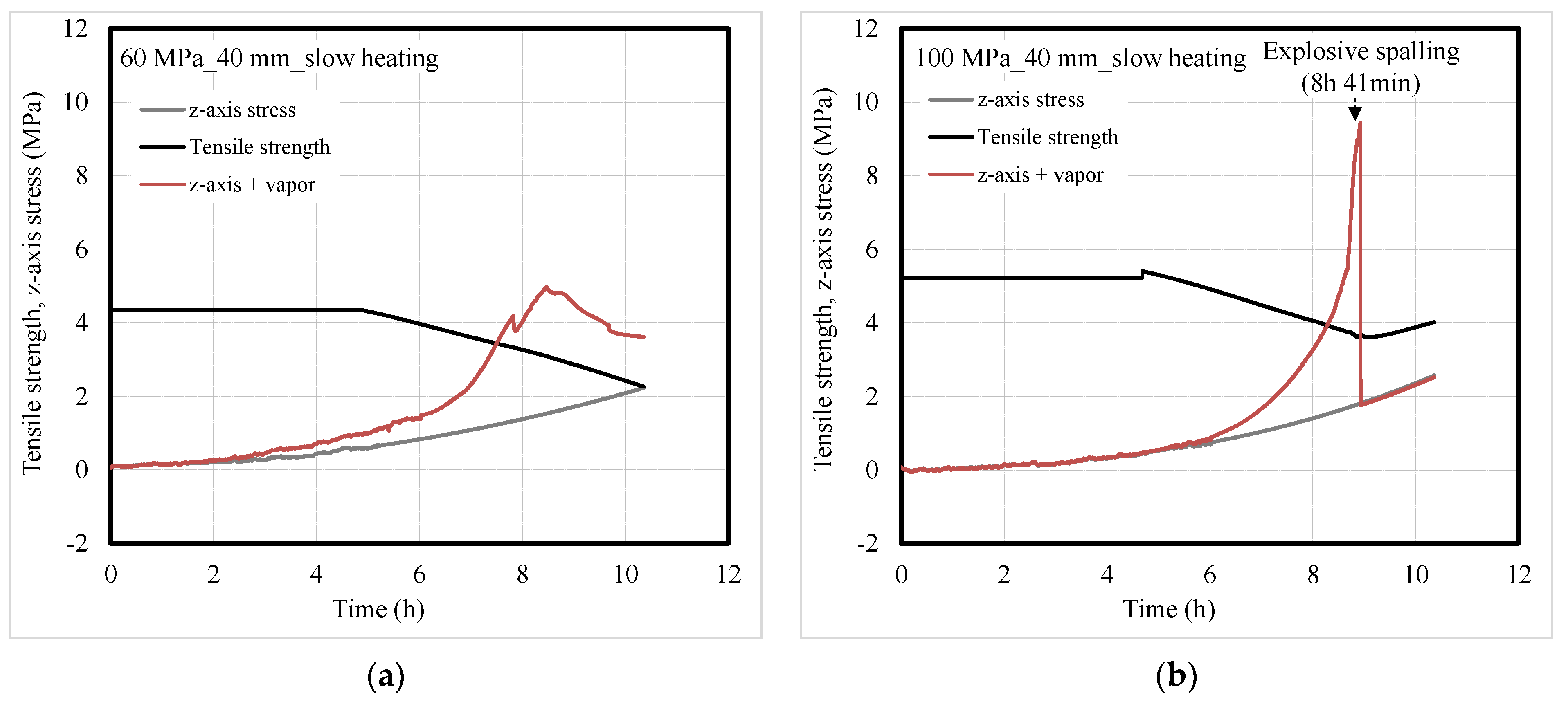

| fck (MPa) | Heating Method | Test Item |
|---|---|---|
| 60 100 | Fast Heating (ISO-834) Slow Heating (1 °C/min.) |
|
| W/B | fck (MPa) | Slump Flow (mm) | Air (%) | S/a (%) | Unit Weight (1) (kg/m3) | |||||
|---|---|---|---|---|---|---|---|---|---|---|
| W | C | FA | SF | S | G | |||||
| 0.35 | 60 | 650 ± 100 | 4 | 40 | 165 | 471 | 0 | 0 | 681 | 1026 |
| 0.20 | 100 | 750 ± 100 | 2 | 43 | 150 | 525 | 150 | 75 | 642 | 870 |
| Material | Physical Property |
|---|---|
| Cement | OPC (density: 3.15 g/cm3, specific surface area: 3200 cm2/g) |
| Fly ash | Density: 2.20 g/cm3, specific surface area: 3000 cm2/g |
| Silica fume | Density: 2.50 g/cm3, specific surface area: 200,000 cm2/g |
| Fine aggregate | Sea sand (density: 2.65 g/cm3, absorption: 1.00%) |
| Coarse aggregate | Crushed granitic aggregate (size: 20 mm, density: 2.62 g/cm3, absorption: 0.8%) |
| Super plasticizer | Polycarboxylic-based super plasticizer |
Publisher’s Note: MDPI stays neutral with regard to jurisdictional claims in published maps and institutional affiliations. |
© 2021 by the authors. Licensee MDPI, Basel, Switzerland. This article is an open access article distributed under the terms and conditions of the Creative Commons Attribution (CC BY) license (https://creativecommons.org/licenses/by/4.0/).
Share and Cite
Hwang, E.; Kim, G.; Choe, G.; Yoon, M.; Son, M.; Suh, D.; Eu, H.; Nam, J. Explosive Spalling Behavior of Single-Sided Heated Concrete According to Compressive Strength and Heating Rate. Materials 2021, 14, 6023. https://doi.org/10.3390/ma14206023
Hwang E, Kim G, Choe G, Yoon M, Son M, Suh D, Eu H, Nam J. Explosive Spalling Behavior of Single-Sided Heated Concrete According to Compressive Strength and Heating Rate. Materials. 2021; 14(20):6023. https://doi.org/10.3390/ma14206023
Chicago/Turabian StyleHwang, Euichul, Gyuyong Kim, Gyeongcheol Choe, Minho Yoon, Minjae Son, Dongkyun Suh, Hamin Eu, and Jeongsoo Nam. 2021. "Explosive Spalling Behavior of Single-Sided Heated Concrete According to Compressive Strength and Heating Rate" Materials 14, no. 20: 6023. https://doi.org/10.3390/ma14206023
APA StyleHwang, E., Kim, G., Choe, G., Yoon, M., Son, M., Suh, D., Eu, H., & Nam, J. (2021). Explosive Spalling Behavior of Single-Sided Heated Concrete According to Compressive Strength and Heating Rate. Materials, 14(20), 6023. https://doi.org/10.3390/ma14206023









